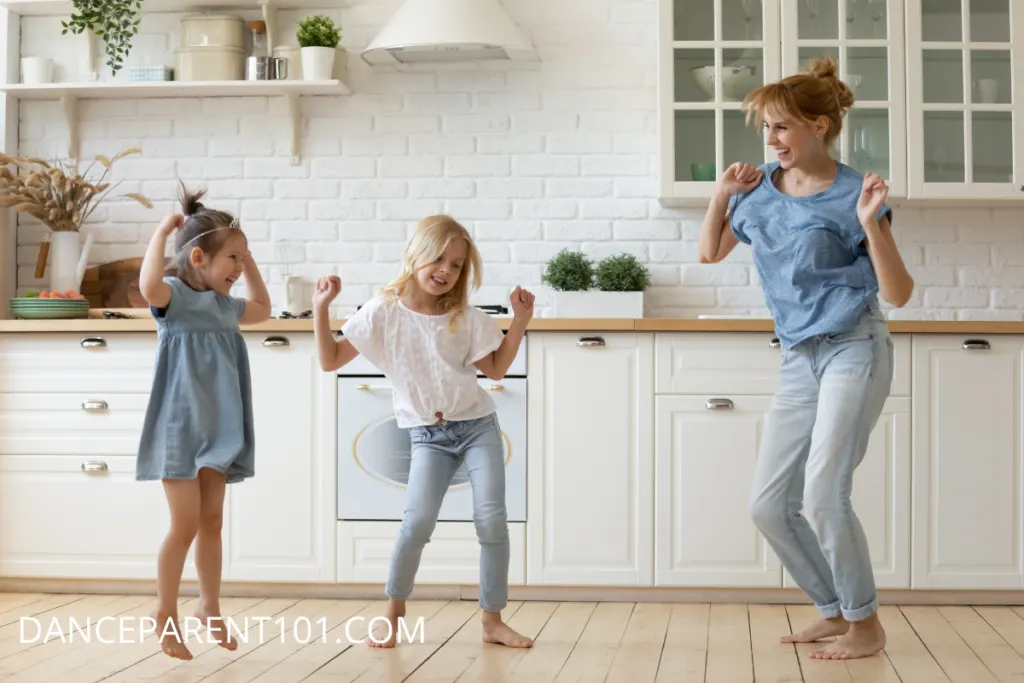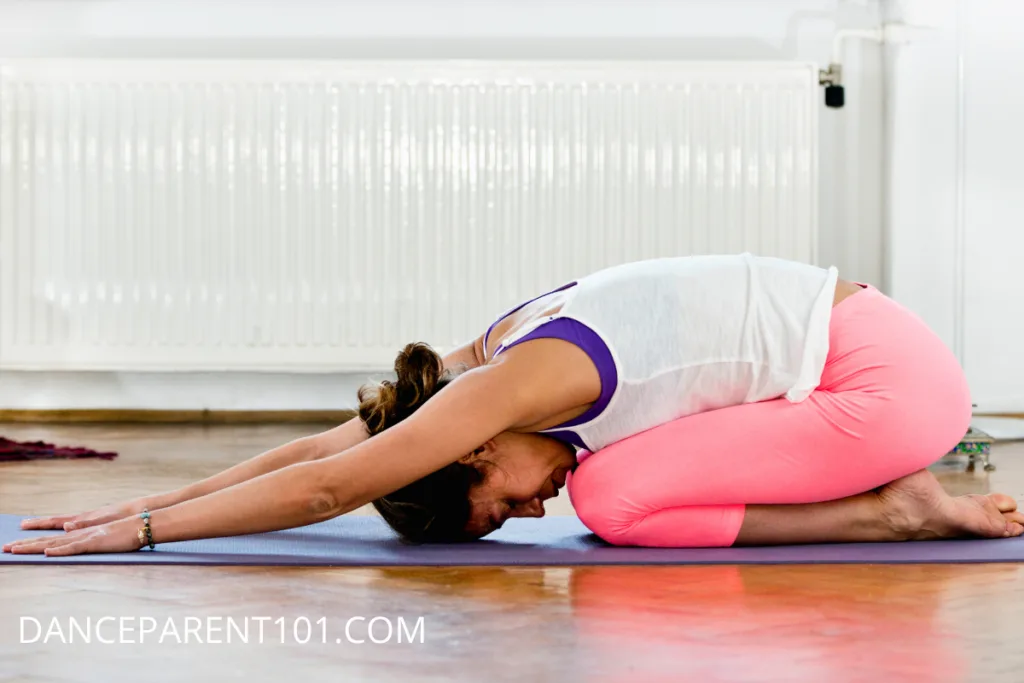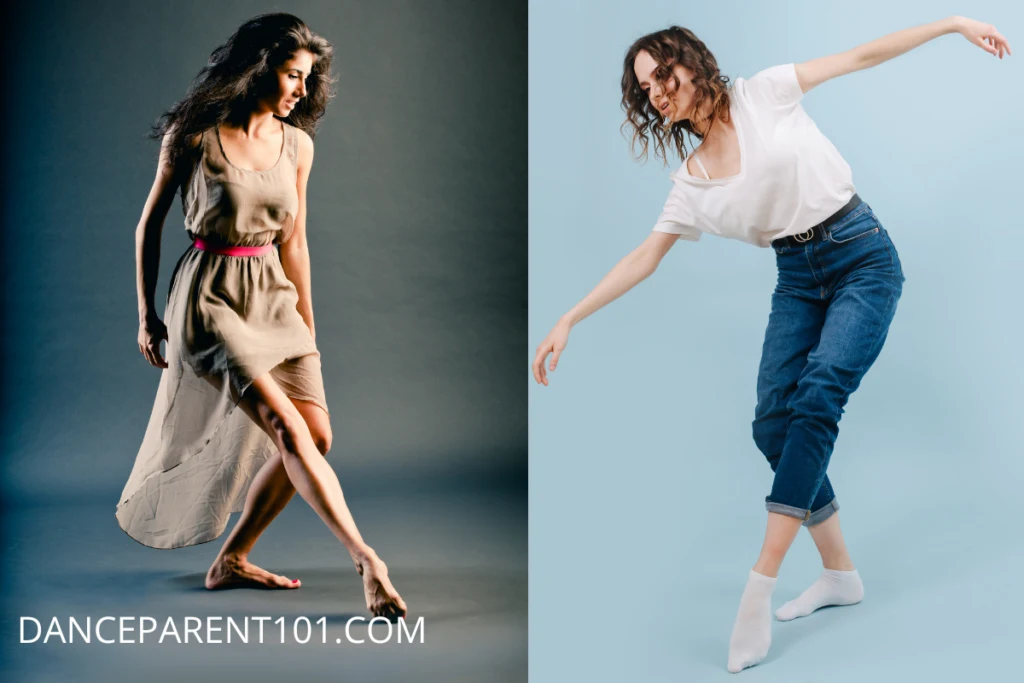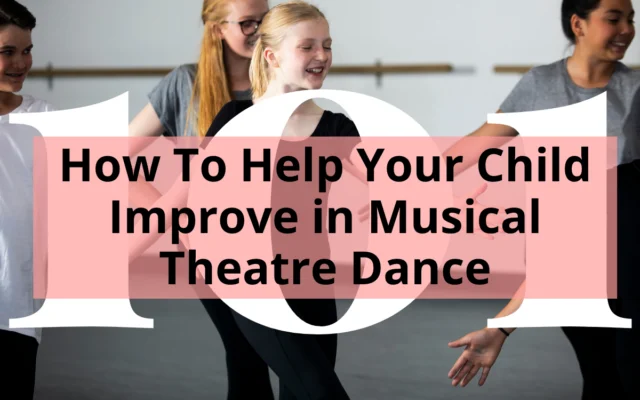By Lesley Mealor / Edited by Samantha Bellerose, B.Ed, Dip.Dance (Performing Arts)
In lyrical dance, we combine the best of the worlds of ballet and jazz, sometimes with a little modern thrown in for fun. But with so many styles fusing into one to create lyrical, it can be hard to pinpoint exactly what dancers should focus on when practicing at home. Luckily, there are several easy and fun exercises you can do with your dancer that will help them improve in lyrical dance!
To help your child improve in lyrical dance, you can use games and exercises that promote musicality. You can also practice exercises for grace and posture.

These kinds of exercises aren’t focused solely on technique – your dancer should be taking both ballet and jazz in conjunction with lyrical to get the necessary technique for this style.
But, just as important as technique, musicality and presentation make a huge difference for young dancers just learning lyrical dance.
If you are looking for the best exercises for jazz and ballet, we’ve got you covered! And for more about what lyrical dance actually entails, check out our informative article here!
Lyrical Exercises For Musicality

Musicality in dance refers to the way a dancer relates and reacts to the music. In lyrical dance, musicality is an important piece of the puzzle because it helps tell the story of the routine.
There are many people who are naturally musical, but for others, it can be difficult to find that inner rhythm and feeling.
Two exercises I like to use for musicality work are Lyrical Freeze Dance, where we incorporate pauses and stillness within movement, and Dance To The Music, where we vary what part of the music we’re moving to. These are fun games that you can use at home to interact with your dancer or a group of dancers!
Lyrical Freeze Dance
Lyrical Freeze Dance is a great game to explore how dancers can use stillness within their movement to create more interesting choreography. Just like in life, if we don’t slow down in dance, we miss out on unique opportunities for creativity.
How To Play Lyrical Freeze Dance
Step One:
To play Lyrical Freeze Dance, all you need is space, music, and your own creative mind! First, pick a piece of music. It can be anything you wish – instrumental, vocal, new, or an old favorite.
Step Two:
Pick a leader who will dictate when the freeze happens. Then, have your dancer (and you too, if you so desire!) start dancing. Allow for creativity. Lyrical is expressive, so have fun and move in a way that feels good.
Step Three:
If you are the leader, pick a moment to say “Freeze!” and the dancer(s) must stop their movement and freeze. Unlike the traditional freeze dance, here we don’t turn off the music.
Instead, to get out of the freeze, you will say, “Melt!” and the dancer has to “melt” out of their pose and begin dancing again.
This helps to demonstrate the value of a pause in movement, as well as different qualities of movement, both of which are part of musicality for dancers.
Lyrical Freeze Dance can be played alone as well, so encourage your dancer to experiment with this exercise on their own. It’s amazing what a little stillness can do!
Dance To The Music

Dance To the Music is another fun exercise that feels like a game but is actually a great teaching tool for musicality.
While most people instinctively dance to the beat or the rhythm, this exercise helps dancers to identify the other parts of the music that we can dance to.
How to Play Dance To The Music
Step One:
First, begin by choosing a piece of music. For this game, you want a song that has lots of things going on – drums, piano, guitar, horns, etc. It might help to choose a piece of music you and your child are familiar with.
Step Two:
Then, lay down, close your eyes, and simply listen to the song. Can you pick out the different parts of the song?
Name out loud the instruments you can hear, sing or scat along with the melody and the lyrics. Become familiar with the structure of the song so that when you stand up, you are ready to play!
Step Three:
Next, play the song again and choose what part of the music to dance to. If you start with the rhythm, you will be moving to anything percussive (drums, cymbals, bass guitar, etc).
If you start with the melody or harmony, you will be dancing to an instrument (maybe a saxophone or piano). If you start with the vocals, you will dance to the lyrics.
This game can actually be pretty challenging if you are not used to dancing to anything other than the beat. Don’t get discouraged – change up the songs, take breaks, and don’t give up! Learning musicality is hard but worth it.
Lyrical Exercises For Posture and Grace

Good posture is important for all people, but dancers especially! In order to maintain good posture, you must develop awareness of what muscles you use to support an upright position.
Both Contract and Release and Child’s Pose help dancers pinpoint the spots they may need to either stretch or strengthen to maintain good posture.
Much of what makes up the graceful parts of lyrical dance comes from ballet. Your dancer is hopefully taking ballet in conjunction with lyrical, but you can never have too much ballet training!
By practicing Ballet Walks and Ballet Walks With Port de Bras, your dancer can fast forward their trajectory to being more graceful in lyrical!
Exercises For Posture
How To Do Contract and Release
Step One:
To practice contract and release, first, find a comfortable spot to sit on the floor. Begin sitting cross-legged, with your back straight, neck long, and both sits bones on the floor. Place your hands on your knees.
Step Two:
Then, contracting your abs, draw the belly button in towards the spine, curl your shoulders forward, and create a “C” shape with your body. That is your contraction. Be sure to keep your neck long and not crunched down. You can move as slowly as you please, but I like to contract for a count of 4.
Step Three:
Next, you will reverse the contraction to release. Press the chest forward, shoulders back, squeezing the shoulder blades back and down, to sit up straight. Release for a count of 4.
Repeat the contract and release 8 times. Not only does this exercise feel great, but it also helps dancers feel and identify the parts of the body that support their posture
How To Do Child’s Pose

Borrowed from the yoga world, child’s pose is an excellent stretch for anyone who sits at a desk all day, slouched and slumped over.
Step One:
To practice child’s pose, begin on your hands and knees with your big toes together, and knees about hip-width apart.
Step Two:
Then, slowly walk your hands forward as far as you can while dropping your rear towards your heels. Your arms should be straight out in front of you.
Step Three:
Next, rest your forehead on the floor. If your nose gets in the way (mine does!), you can turn your head to one side or use a small pillow or folded towel under your forehead.
Hold this position for 8 breaths. Concentrate on feeling the openness of your chest. Experiment with where you place your hands, and how wide you open your knees. Every body is different and what feels good to one person may not feel good to another!
Exercises For Grace

How To Do Ballet Walks
Ballet walks are simply graceful, slow walks that incorporate turn out, pointed feet, and good posture. These can be practiced anywhere. Because describing ballet walks includes ballet terminology, we’ve included some helpful photos to show you what we mean!
Step One:
Begin by standing in B-plus (left leg in first position, right foot behind with big toe on the ground), with arms en bas (low fifth position).
Step Two:
Then, slowly bring the right foot through sur le coup de pied forward, stepping onto the foot toe-ball-heel, presenting the heel forward. Repeat on the left.
Step Three:
Walk all the way across the room, focusing on maintaining the turnout of both legs while walking and imagining you are gliding across the floor!
The following video shows Samantha Bellerose the Creator of Dance Parent 101 show an example of ballet walks in a kid’s movement video on the Move Dance Learn Youtube Channel.
How To Do Ballet Walks With Port de Bras, or “Arm-ography”
Much of what makes lyrical dance stand out from ballet is the variety of port de bras, or as I like to call it, “arm-ography”, that can be used. How the upper body is carried in lyrical makes a huge difference in how choreography looks.
Practicing ballet walks, as described above, can be enhanced by adding interesting arms.
Step One:
Begin with a standard ballet port de bras, coming from en bas, to en haut, opening into second position and back down to en bas. Change positions every time you step.
Step Two:
You may then reverse that sequence. Practice the basic port de bras several times to get the timing right.
Step Three:
Then, experiment with your own arm-ography! Add the upper body, add epaulement, or “shouldering”, change the timing. The sky’s the limit!
With these exercises, hopefully, your dancer is well on their way to becoming more comfortable with lyrical dance. Developing their musicality, grace, and posture will also translate into the other styles of dance they study, and even into their everyday life.















